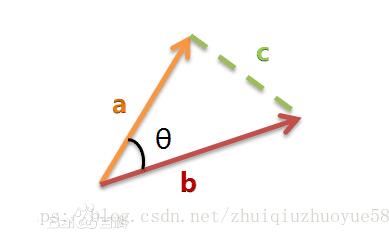Python 求向量的余弦值操作
余弦相似度衡量的是2個(gè)向量間的夾角大小,通過夾角的余弦值表示結(jié)果,因此2個(gè)向量的余弦相似度為:

余弦相似度的取值為[-1,1],值越大表示越相似。
向量夾角的余弦公式很簡單,不在此贅述,直接上代碼:
def cosVector(x,y): if(len(x)!=len(y)): print(’error input,x and y is not in the same space’) return; result1=0.0; result2=0.0; result3=0.0; for i in range(len(x)): result1+=x[i]*y[i] #sum(X*Y) result2+=x[i]**2 #sum(X*X) result3+=y[i]**2 #sum(Y*Y) #print(result1) #print(result2) #print(result3) print('result is '+str(result1/((result2*result3)**0.5))) #結(jié)果顯示cosVector([2,1],[1,1])一個(gè)計(jì)算二維數(shù)組余弦值的例子:
#求余弦函數(shù)def cosVector(x,y): if(len(x)!=len(y)): print(’error input,x and y is not in the same space’) return; result1=0.0; result2=0.0; result3=0.0; for i in range(len(x)): result1+=x[i]*y[i] #sum(X*Y) result2+=x[i]**2 #sum(X*X) result3+=y[i]**2 #sum(Y*Y) #print('result is '+str(result1/((result2*result3)**0.5))) #結(jié)果顯示 return result1/((result2*result3)**0.5)#print('result is ',cosVector([2,1],[1,1])) #計(jì)算query_output(60,20)和db_output(60,20)的余弦值,用60*1的向量存儲(chǔ) cosResult= [[0]*1 for i in range(60)] for i in range(60): cosResult[i][0]=cosVector(query_output[i], db_output[i]) print(cosResult)--------------------------------------------------------------------------------------------#計(jì)算query_output和db_output的余弦值,用60*1的向量存儲(chǔ)rows=query_output.shape[0] #行數(shù)cols=query_output.shape[1] #列數(shù)cosResult= [[0]*1 for i in range(rows)] for i in range(rows): cosResult[i][0]=cosVector(query_output[i], db_output[i]) #print(cosResult)#將結(jié)果存入文件中,并且一行一個(gè)數(shù)字file=open(’cosResult.txt’,’w’)for i in cosResult: file.write(str(i).replace(’[’,’’).replace(’]’,’’)+’n’) #rn為換行符 file.close()
補(bǔ)充:python實(shí)現(xiàn)余弦近似度
方法一:def cos(vector1,vector2): dot_product = 0.0 normA = 0.0 normB = 0.0 for a,b in zip(vector1,vector2): dot_product += a*b normA += a**2 normB += b**2 if normA == 0.0 or normB==0.0: return None else: return 0.5 + 0.5 * dot_product / ((normA*normB)**0.5) #歸一化 <span style='font-family: Arial, Helvetica, sans-serif;'>從[-1,1]到[0,1]</span>方法二:
num = float(A.T * B) #若為行向量則 A * B.Tdenom = linalg.norm(A) * linalg.norm(B)cos = num / denom #余弦值sim = 0.5 + 0.5 * cos #歸一化 從[-1,1]到[0,1]
以上為個(gè)人經(jīng)驗(yàn),希望能給大家一個(gè)參考,也希望大家多多支持好吧啦網(wǎng)。如有錯(cuò)誤或未考慮完全的地方,望不吝賜教。
相關(guān)文章:
1. python爬蟲實(shí)戰(zhàn)之制作屬于自己的一個(gè)IP代理模塊2. HTML 絕對(duì)路徑與相對(duì)路徑概念詳細(xì)3. python實(shí)現(xiàn)PolynomialFeatures多項(xiàng)式的方法4. IntelliJ IDEA設(shè)置默認(rèn)瀏覽器的方法5. Spring如何使用xml創(chuàng)建bean對(duì)象6. python實(shí)現(xiàn)在內(nèi)存中讀寫str和二進(jìn)制數(shù)據(jù)代碼7. Java程序的編碼規(guī)范(6)8. Android Studio設(shè)置顏色拾色器工具Color Picker教程9. python 利用toapi庫自動(dòng)生成api10. Python paramiko 模塊淺談與SSH主要功能模擬解析

 網(wǎng)公網(wǎng)安備
網(wǎng)公網(wǎng)安備